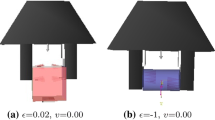Abstract
In this article, we introduce the extended grasp wrench space (GWS) to identify the applied location and the magnitude of the critical external wrench. We jointly use the task wrench space (TWS), which is made up of all possible external wrenches produced from the unit normal force to the surface points of the grasped object (i.e., the object wrench space [OWS]). In the extended GWS, the torque bound of each joint of the robot hand is considered to determine the grasp capability. Through convexity analysis and a linear programming technique, we propose a new way of obtaining an enhanced grasp measure which shows a clear physical meaning. We verify the proposed grasp analysis and quality measure using a visual grasp simulator and polygonal objects of various shapes.
Similar content being viewed by others
Explore related subjects
Discover the latest articles, news and stories from top researchers in related subjects.References
Liu YH, Ding D, Lam ML (2004) 3-D grasp analysis and synthesis using the ray-shooting technique. Robotics Welding, Intelligence and Automation, LNCIS 299, Springer, Berlin, pp 80–109
Goldfeder C, Allen PK, Kackner C, et al (2007) Grasp planning via decomposition tree. Proceedings of the IEEE International Conference on Robotics and Automation, Roma, Italy, IEEE, pp 4679–4684
Kirkpatrick D, Mishra B, Yap C-K (1990) Quantitative Steinitz’s theorem with applications to multifingered grasping. Proceedings of the 20th ACM Symposium on the Theory of Computing, Baltimore, USA, ACM, pp 341–351
Li Z, Sastry SS (1988) Task-oriented optimal grasping by multifingered robot hands. IEEE J Robotics Autom 4:32–44
Pollard NS (1994) Parallel methods for synthesizing whole-hand grasps from generalized prototypes. Technical Report AI-TR 1464, MIT Artificial Intelligence Laboratory
Borst Ch, Fischer M, Hirzinger G (2004) Grasp planning: how to choose a suitable task wrench space. Proceedings of the IEEE International Conference on Robotics and Automation, vol 1, New Orleans, USA, IEEE, pp 319–325
Jeong H, Park J, Cheong J (2008) Grasp planning for three-fingered robot hands using taxonomy-based preformed grasp and object primitives. J Korea Robotics Soc 3:123–130
Author information
Authors and Affiliations
Corresponding author
Additional information
This work was presented in part and was awarded the Best Paper Award at the 14th International Symposium on Artificial Life and Robotics, Oita, Japan, February 5–7, 2009
About this article
Cite this article
Jeong, H., Park, J. & Choeng, J. A new grasp quality measure considering the physical limits of robot hands. Artif Life Robotics 14, 524–527 (2009). https://doi.org/10.1007/s10015-009-0723-9
Received:
Accepted:
Published:
Issue Date:
DOI: https://doi.org/10.1007/s10015-009-0723-9




